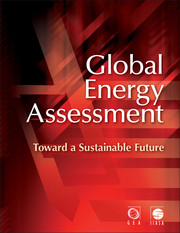Book contents
- Frontmatter
- Contents
- Section 1
- Section 2
- Section 3
- Cluster 1
- Cluster 2
- Chapter 7 Energy Resources and Potentials
- Chapter 8 Energy End-Use: Industry
- Chapter 9 Energy End-Use: Transport
- Chapter 10 Energy End-Use: Buildings
- Chapter 11 Renewable Energy
- Chapter 12 Fossil Energy
- Chapter 13 Carbon Capture and Storage
- Chapter 14 Nuclear Energy
- Chapter 15 Energy Supply Systems
- Chapter 16 Transitions in Energy Systems
- Cluster 3
- Cluster 4
- Section 4
- Index
- References
Chapter 10 - Energy End-Use: Buildings
Published online by Cambridge University Press: 05 September 2012
- Frontmatter
- Contents
- Section 1
- Section 2
- Section 3
- Cluster 1
- Cluster 2
- Chapter 7 Energy Resources and Potentials
- Chapter 8 Energy End-Use: Industry
- Chapter 9 Energy End-Use: Transport
- Chapter 10 Energy End-Use: Buildings
- Chapter 11 Renewable Energy
- Chapter 12 Fossil Energy
- Chapter 13 Carbon Capture and Storage
- Chapter 14 Nuclear Energy
- Chapter 15 Energy Supply Systems
- Chapter 16 Transitions in Energy Systems
- Cluster 3
- Cluster 4
- Section 4
- Index
- References
Summary
Executive Summary
Buildings are key to a sustainable future because their design, construction, operation, and the activities in buildings are significant contributors to energy-related sustainability challenges – reducing energy demand in buildings can play one of the most important roles in solving these challenges. More specifically:
The buildings sector and people's activities in buildings are responsible for approximately 31% of global final energy demand, approximately one-third of energy-related CO2 emissions, approximately two-thirds of halocarbon, and approximately 25–33% of black carbon emissions.
Several energy-related problems affecting human health and productivity take place in buildings, including mortality and morbidity due to poor indoor air quality or inadequate indoor temperatures. Therefore, improving buildings and their equipment offers one of the entry points to addressing these challenges.
More efficient energy and material use, as well as sustainable energy supply in buildings, are critical to tackling the sustainability-related challenges outlined in the GEA. Recent major advances in building design, know-how, technology, and policy have made it possible for global building energy use to decline significantly. A number of lowenergy and passive buildings, both retrofitted and newly constructed, already exist, demonstrating that low level of building energy performance is achievable. With the application of on-site and community-scale renewable energy sources, several buildings and communities could become zero-net-energy users and zero-greenhouse gas (GHG) emitters, or net energy suppliers.
Recent advances in materials and know-how make new buildings that use 10–40% of the final heating and cooling energy of conventional new buildings cost-effective in all world regions and climate zones.
- Type
- Chapter
- Information
- Global Energy AssessmentToward a Sustainable Future, pp. 649 - 760Publisher: Cambridge University PressPrint publication year: 2012
References
- 56
- Cited by



